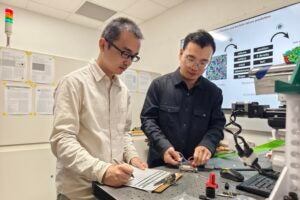In February, the University launched Change Starts With Us — an employee-focused campaign designed to bring together key strategic plan initiatives and programs as an extension of Change Starts Here.

The campaign, co-led by Roger Cude, Vice President for People and Talent, and Ann Stevens, Dean of the College of Liberal Arts, kicked off with the first campuswide employee data and insights collection effort since 2017. The Change Starts With Us employee experience survey, which opened February 20 and concluded March 15, provided employees an opportunity to have their voice heard by University leaders, from executive leaders down to people managers.
“The first step in our People and Talent journey to realize the aspirations outlined in Change Starts Here to be a premier faculty and staff employer is to get baseline data, which we hadn’t collected as a University in several years,” Cude said. “Our faculty and staff have voiced where there is room for improvement and where things are working well. Now that we have gathered the sentiments, leaders across campus are rolling up their sleeves and planning for improvement.”
Cude said data is currently being shared with President Jay Hartzell and other University leaders. Upon review by leadership, data will then be shared with the larger community in the coming weeks and months in preparation for the action planning phase.
“This campuswide effort represents a commitment to track progress on our people and talent initiative,” Stevens said, “and will help leaders at all levels measure progress over time. This removes the need for different employee surveys across campus and will help deans and vice presidents develop a more systematic approach to how we plan for gains in employee engagement and enablement.”
Elida Lee, Director of Organization Effectiveness in People and Talent, is leading that action planning effort. She will work closely with deans and vice presidents to ensure plans developed by colleges, schools and units are informed by their specific survey results.
“Hearing directly from faculty and staff helps leadership understand how and why employees feel a certain way, how enabled and engaged employees feel about their work, and where there is need for improvement and where we are already creating positive employee experiences,” Lee said. “These insights are helping campus leaders develop action plans they can be putting into place over this next academic year. Subsequent surveys will help us measure progress over time and test how actions improve engagement and enablement.”
Over the next several months, University leaders will be digging in to understand their aggregated data and their employee responses.
“This will be an ongoing, iterative process,” Cude said. “We have more work to do as a leadership group and as a campus. It is not an overnight process but represents long term, strategic work from executive leadership down to every manager and supervisor on campus. Our ultimate goal is for our faculty and staff to report they are more engaged and better able to perform at their best.”
Lee said the University’s new approach, led by third party vendors Korn Ferry and Qualtrics, focuses on measuring two key data points: employee engagement and enablement. Employee engagement is best defined by an employee’s commitment to helping their organization achieve its overall goals. Employee enablement assesses whether employees have the skills and University support to get their work done
“This is why we are intentional about calling this an employee experience survey and not an engagement survey like in years past,” Lee said. “The combination of employee engagement and enablement gives us a better picture and understanding of the overall employee experience and gives us a better pathway toward improving that experience from a holistic perspective.”



